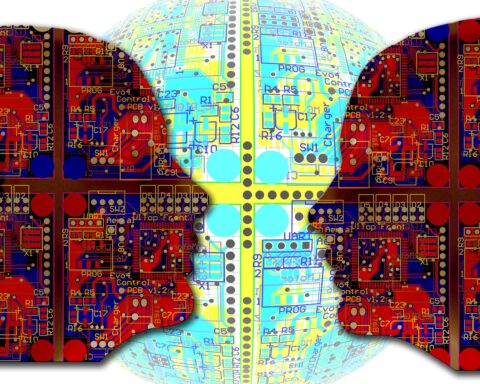Data volume on the Internet of Things (IoT) is increasing twice as fast as that of social networks. By 2020 the number of connected devices will grow to 29 billion from 13 billion today. Nine years from now the value of the data generated by these devices will be around $11 billion. Around 70 percent of this increase in value due to the IoT will be a result of greater efficiency in factories and connected value chains. Increasingly often, these developments will lead at the same time to massive changes in the context of established business models. That is how corporations themselves see it. According to a recently published IBM study1, one company in two in Germany is expecting its business model to be attacked by competitors from outside its industry. Internationally, the story is much the same. Over 80 percent of decision makers in corporations around the world expect the growing influence of the IoT to have strategic or transformative effects on their company. As the IoT is still in its early days, active use is currently only made of around 12 percent of data generated on factory floors and in value chains. This enormous gap must be closed with regard to boosting the productivity, flexibility, and agility of companies, to establishing new business models, to taking innovations forward and to satisfying customer needs better.
Creating the Right Preconditions
If these objectives are to be achieved, however, a number of preconditions must first be created – seamless access to data from management and business systems and to production systems in manufacturing, for example. That is the only way in which highly individualized products can be manufactured in mass production conditions. This is also known as Lot Size One, which is a central claim for the use of the IoT in digital transformation or Industry 4.0 projects. In addition, data recorded via the IoT must be collected and, as far as possible, evaluated smartly. That is much easier to do than a few years ago, due mainly to three developments:
- Many modern machines already collect data or are relatively easy to upgrade with additional sensors. They are connected with each other or with central IT systems using industry communication standards.
- Even large amounts of data can be processed in real time. Furthermore, these data volumes are relatively inexpensive to store in, say, the cloud.
- Current software analysis solutions enable evaluation to be embedded directly in production processes so that direct use can be made of knowledge generated from data.
From Theory to Practice
An as yet fictional example combining traditional manufacturing and 3D printing makes it clear what is theoretically possible on this basis. 3D printing, much like the digital factory itself, presents totally new opportunities with strongly disruptive tendencies. In the future, for example, motor vehicle manufacturers could allow authorized dealers to print out plastic and metal parts independently while themselves only producing the technically advanced components at their factories. That would make it possible to transfer parts of production swiftly and flexibly straight to the sales markets and, moreover, to adapt them to specific markets and market requirements. Servicing and repairs also stand to benefit because defective parts could then also be printed out on site. An approach of this kind would correspond to the Lot Size One ideal and also deliver important benefits for the spare parts business, such as lower storage costs for parts that are less frequently required or shorter waiting times for the repair itself.
The ski manufacturer Blizzard demonstrates what is possible in practice today. It uses a so-called “near-real time” production management system that is linked directly to its ERP system. On the basis of sensor data collected and evaluated along the manufacturing process it identifies problems at an early stage and helps to solve them. Production flow times and inventory costs could each be reduced by about half. In addition, the system puts in place the preconditions for even more flexible production geared to demand by taking external data such as latest market analyses into account.
Another example is a pilot project – still in its early days – with John Deere, one of the world’s oldest and most successful tractor manufacturers, under way at the company’s largest European production site in Mannheim. Jointly with partners a new platform was developed that provides both production line workers and production planning and optimization with important assistance, decision-making criteria and automation opportunities. The platform’s most important feature is its ability to process different data protocols and thereby controlling production processes centrally.
From Airplane Engine to Smart Home: New Service Models
On the factory floor the main aim is to ensure an unlimited communication capability between machines, but a further focus of the IoT or the Industrial Internet is on connecting and monitoring machinery and equipment beyond the bounds of one’s own factory workshops.
This data also helps to shape new business models. Its focus is on developing new services and operating models. Interesting options result, for example, from combining services with leasing or rental models. They range from coffee machines and painting systems to turbines. The plant and machinery remain the property of the manufacturer, but payment is based on performance and availability, such as the coffee consumption, the number of car bodies painted or the flying hours logged. This may not be fundamentally new but fundamentally improved access to operating data, in real time if need be, offers enormous advantages, such as in respect of timely delivery of new coffee beans or of predictive maintenance of airplane engines.
Aero engine manufacturers like Rolls-Royce use solutions of this kind already. On the customer’s behalf the condition of engines is monitored at service centers that are manned around the clock. To enable this to be done, analysis programs plow through terabytes of data in flight, covering dozens of parameters such as temperatures, pressures, vibrations, or rev counts, and highlight the outliers. In certain in-flight phases this irregular data is then sent bundled via satellite to the service centers for evaluation. It forms the basis for engine health monitoring or for predictive maintenance and enables maintenance to be optimized and parts that may be required to be shipped to the airport before the plane has even landed. Nobody can do that better than the manufacturer who knows his engines and has the largest quantity of data. That is how Rolls-Royce ensures the best possible availability of the engines and thereby of the airplanes themselves.
The Smart Home will also benefit from the IoT. Issues such as predictive maintenance, software updates from the internet, management, remote diagnosis and troubleshooting in real time – everything that is undertaken already in many factories – have yet to be solved. But Diehl Controls aims to change that. The manufacturer of smart sensors and control technology has developed a cloud platform jointly with us on which, for the first time, data from connected devices made by different manufacturers can be collected, monitored, evaluated and analyzed. And not only that: new service models will enable manufacturers or suppliers to provide or arrange for services directly online.
Cognitive Computing: Bringing more Knowledge to Decisions and Processes
A further step in the development of business models is the integration of cognitive applications –self-learning IT systems that communicate with people and other computer systems in real time, remember previous interactions and independently draw conclusions. In so doing, they take their environment into account and rapidly process large quantities of data from highly diverse sources. Cognitive computing brings technology a step closer to humans by supporting them in their decision making in numerous areas of life and work. A learning system, such as IBM Watson, is able to read millions of text documents in seconds. In doing so it follows the principles of understanding, learning, and evaluating. These systems thereby model our thought processes to a certain extent. Almost all industries could benefit from the use of this technology, be it healthcare or finance, manufacturing industry or commerce.
These new systems are capable of doing more than calculating what they have been programmed for. They can learn and try to understand humans, their intentions and wishes. They register nuances in human semantics and interact with people. Moreover, these boundaries are continuously shifted further. For example, a system like Watson will soon be able to interpret data that cannot even be detected by the human senses, such as infrared radiation or sonar. And so it goes on. IBM scientists are already testing new materials beyond silicon to lay the technological groundwork for even more processing power so that data processing limits faced by these developments are less restrictive.
Learning in context
Cognitive systems interpret data in order to recognize patterns and connections and to gain new knowledge. They can do this faster than any person or group. But to be able to evaluate this content correctly, they need additional training – by subject matter experts who help with the classification. And in exactly the same way as the human experts, they use a cognitive frame of reference for a specific topic or a defined specialist field and develop their expertise on this basis – at inconceivable speed. This is where the decisive difference lies. While the programming of conventional computer systems is based on rules and logic subject to a rigid decision tree, the cognitive system follows another approach that is similar to the human thought process.
Expanding the knowledge
In medicine, knowledge about illnesses, new therapies and treatments is growing by the day. Learning systems can help doctors to access, analyze and evaluate all possible sources. Amongst these sources are current findings of examinations and diagnostic tools, treatment guidelines, electronic health records, research results, clinical studies, articles in medical journals, and much more. In this way a more precise diagnosis can be achieved or a complex medical decision can be made faster. Yet the final decision remains with the physician.
Another relevant example from real life is the employment of the Watson cognitive system by Swiss Re. Here too, cognitive technologies combined with human experience support and improve risk calculations as well as helping them to be more precise. The system supports Swiss Re by, but not only by, identifying patterns and establishing links so that information can be interpreted in the right context.
So a new course is being set, and the tools for it exist. The frequently used slogan for it is Industry 4.0, a synonym for the fourth industrial revolution, which is in full swing. With creativity and delight in innovation, with a modicum of readiness to run risks, and with willingness to forge new alliances traditional companies also stand a chance of holding their own successfully in times of economic upheaval.
1Redefining Bounderies, IBM Global C-Suite Study, IBM Institute for Business Value, Oct. 2015










